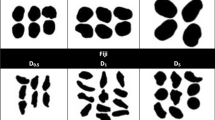Abstract
The relationship between the rheological properties of deionized aqueous suspensions of hectorite particles and the dispersion states of the particles has been studied with a broad range of salt and particle concentrations. The shear viscosity of the hectorite suspensions decreases drastically after exhaustively deionizing the suspensions with ion-exchange resins. By means of DLS measurements, it is clarified that the average size of the flocs of hectorite particles decreases and reaches the Stokes diameter of the individual particle as the degree of deionization advances. This fact strongly supports the idea that the electrical double layer around the hectorite particles expands significantly in the exhaustively deionized state and the particles are well-dispersed individually and do not form a three-dimensional network structure composed of particles, whereas such a network structure forms in the presence of a large amount of salt. In the case of exhaustively deionized state, the suspension forms a glassy state, at high particle fractions. The results show the importance of the electrical double layer that causes a strong repulsive force among the particles on the particle dispersion state, especially in the exhaustive deionization area below 10 − 4 M, and on the rheological properties; the hectorite suspension can be considered a Newtonian liquid in the deionized state, but it becomes elastic-solid in the presence of salt above a certain concentration confirmed by normal stress measurements.










Similar content being viewed by others
References
Bonn D, Tanaka H, Wegdam G, Kellay H, Meunier J (1998) Aging of a colloidal “Wigner” glass. Europhys Lett 45:52–57
Gabriel J-CP, Sanchez C, Davidson P (1996) Observation of nematic liquid-crystal textures in aqueous gels of smectite clays. J Phys Chem 100:11139–11143
Hachisu S, Kobayashi Y, Kose A (1973) Phase separation in monodisperse lattices. J Colloid Interface Sci 42:342–348
Ishijima H, Kudo M, Masuko T (2000) Effect of pH on rheological properties of synthetic hectorite/water suspensions. J Soc Rheology Japan 28:79–83
Jennings BR, Parslow K (1988) Particle size measurement: the equivalent spherical diameter. Proc R Soc Lond A 419:137–149
Kimura H, Nakayama Y, Tsuchida A, Okubo T (2007) Rheological properties of deionized Chinese ink. Colloids Surf B 56:236–240
Kroon M, Vos WL, Wegdam GH (1998) Structure and formation of a gel of colloidal disks. Phys Rev E 57:1962–1970
Kumar A, Wu J (2004) Structural and dynamic properties of colloids near jamming transition. Colloids Surf A 247:145–151
Levitz P, Lecolier E, Mourchid A, Delville A, Lyonnard S (2000) Liquid–solid transition of Laponite suspensions at very low ionic strength: long-range electrostatic stabilization of anisotropic colloids. Europhys Lett 49:672–677
Malkin AY, Masalova I (2007) Shear and normal stresses in flow of highly concentrated emulsions. J Non-Newton Fluid Mech 147:65–68
Masuko T, Kudo M, Ishijima H, Yamagata Y (2001) Effect of additive NaCl on rheological characteristics of synthetic hectorite aqueous suspensions. J Soc Rheology Japan 29:139–143
Mongondry P, Tassin JF, Nicolai T (2005) Revised state diagram of Laponite dispersions. Coll Interf Sci 283:397–405
Mori Y, Togashi K, Nakamura K (2001) Colloidal properties of synthetic hectorite clay dispersion measured by dynamic light scattering and small angle X-ray scattering. Adv Powder Technol 12:45–59
Mourchid A, Delville A, Lambard J, Lecolier E, Levitz P (1995a) Phase diagram of colloidal dispersions of anisotropic particles: equilibrium properties, structure, and rheology of Laponite suspensions. Langmuir 11:1942–1950
Mourchid A, Delville A, Levitz P (1995b) Sol–gel transition of colloidal suspensions of anisotropic particles of Laponite. Faraday Discuss 101:275–285
Okubo T (1992) Suspension structures of deionized colloidal spheres as studied by the reflection and transmission spectroscopy. Ber Bunsenges Phys Chem 96:61–68
Okubo T, Aotani S (1988) Microscopic observation of ordered colloids in sedimentation equilibrium and the importance of Debye-screening length. 8. Unsymmetrical ordering and inclusion of anisotropic particles. Colloid Polym Sci 266:1049–1057
Okubo T, Kimura H, Hatta T, Kawai T (2002) Rheo-optical study of colloidal crystals. Phys Chem Chem Phys 4:2260–2263
Omari A, Tabary R, Rousseau D, Omari A, Calderon FL, Monteil J, Chauveteau G (2006) Soft water-soluble microgel dispersions: structure and rheology. J Colloid Interface Sci 302:537–546
Ramsay JDF, Lindner P (1993) Small-angle neutron scattering investigations of the structure of thixotropic dispersions of smectite clay colloids. J Chem Soc Faraday Trans 89:4207–4214
Schosseler F, Kaloun S, Skouri M, Munch JP (2006) Diagram of the aging dynamics in Laponite suspensions at low ionic strength. Phys Rev E 73:021401
Tanaka H, Meunier J, Bonn D (2004) Nonergodic states of charged colloidal suspensions: repulsive and attractive glasses and gels. Phys Rev E 69:031404
Tawari SL, Koch DL, Cohen C (2001) Electrical double-layer effects on the Brownian diffusivity and aggregation rate of Laponite clay particles. J Colloid Interface Sci 240:54–66
Thompson DW, Butterworth JT (1992) The nature of Laponite and its aqueous dispersions. J Colloid Interface Sci 151:236–243
Van Olphen H (1977) An introduction to clay colloid chemistry. Wiley, New York
Acknowledgements
The authors are appreciative of Kunimine Industries Co., Ltd., for providing the fine hectorite particles. This research is supported by Instrumental Analysis, Life Science Research Center, Gifu University, for sample characterization. H. K. acknowledges the support of Ministry of Education, Culture, Sports, Science and Technology, the Knowledge Cluster Initiative (the Second Stage) ∼Tokai Region Nanotechnology Manufacturing Cluster∼.
Author information
Authors and Affiliations
Corresponding author
Rights and permissions
About this article
Cite this article
Kimura, H., Sakurai, M., Sugiyama, T. et al. Dispersion state and rheology of hectorite particles in water over a broad range of salt and particle concentrations. Rheol Acta 50, 159–168 (2011). https://doi.org/10.1007/s00397-011-0532-7
Received:
Revised:
Accepted:
Published:
Issue Date:
DOI: https://doi.org/10.1007/s00397-011-0532-7




